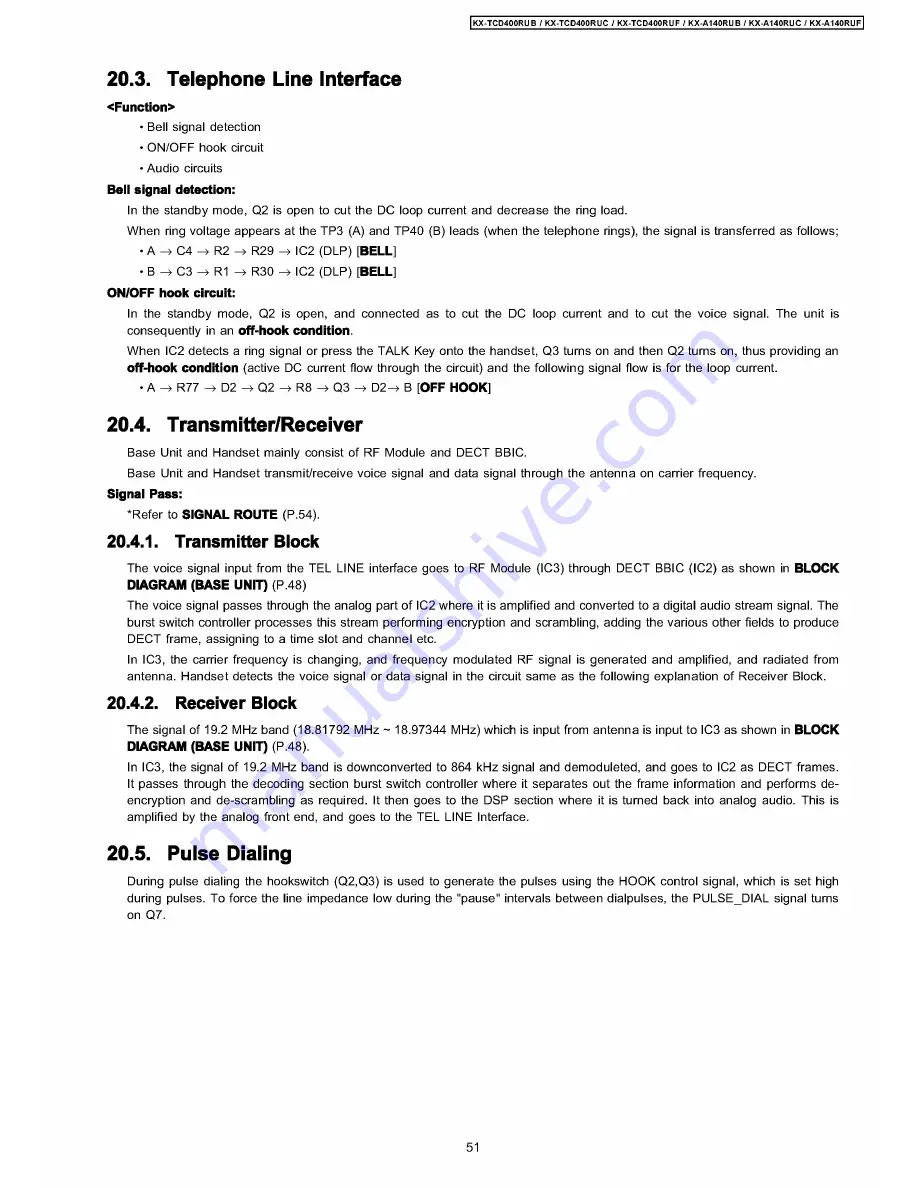
KX-TCD400RUB
I
KX-TCD400RUC
I
KX-TCD400RUF
I
KX-A140RUB
I
KX-A140RUC
I
KX-A140RUF
20.3. Telephone Line Interface
<Function>
• Bell signal detection
• ON/OFF hook circuit
• Audio circuits
Bell signal detection:
In the standby mode, Q2 is open to cut the DC loop current and decrease the ring load.
When ring voltage appears at the TP3 (A) and TP40 (B) leads (when the telephone rings), the signal is transferred as follows;
• A ^ C4 ^ R2 ^ R29 ^ IC2 (DLP) [
BELL
]
• B ^ C3 ^ R1 ^ R30 ^ IC2 (DLP) [
BELL
]
ON/OFF hook circuit:
In the standby mode, Q2 is open, and connected as to cut the DC loop current and to cut the voice signal. The unit is
consequently in an
off-hook condition
.
When IC2 detects a ring signal or press the TALK Key onto the handset, Q3 turns on and then Q2 turns on, thus providing an
off-hook condition
(active DC current flow through the circuit) and the following signal flow is for the loop current.
• A ^ R77 ^ D2 ^ Q2 ^ R8 ^ Q3 ^ D 2 ^ B [
OFF HOOK
]
20.4. Transmitter/Receiver
Base Unit and Handset mainly consist of RF Module and DECT BBIC.
Base Unit and Handset transmit/receive
voice signal and
data signal through the antenna on carrier frequency.
Signal Pass:
*Refer to
SIGNAL ROUTE
(P.54).
20.4.1. Transmitter Block
The voice signal input from the TEL LINE interface goes to RF Module (IC3) through DECT BBIC (IC2) as shown in
BLOCK
DIAGRAM (BASE UNIT)
(P.48)
The voice signal passes through the analog part of IC2 where it is amplified and converted to a digital audio stream signal. The
burst switch controller processes this stream performing encryption and scrambling, adding the various other fields to produce
DECT frame, assigning to a time slot and channel etc.
In IC3, the carrier frequency is changing, and frequency modulated RF signal is generated and amplified, and radiated from
antenna. Handset detects the voice signal or data signal in the circuit same as the following explanation of Receiver Block.
20.4.2. Receiver Block
The signal of 19.2 MHz band (18.81792 MHz ~ 18.97344 MHz) which is input from antenna is input to IC3 as shown in
BLOCK
DIAGRAM (BASE UNIT)
(P.48).
In IC3, the signal of 19.2 MHz band is downconverted to 864 kHz signal and demoduleted, and goes to IC2 as DECT frames.
It passes through the decoding section burst switch controller where it separates out the frame information and performs de
encryption and de-scrambling as required. It then goes to the DSP section where it is turned back into analog audio. This is
amplified by the analog front end, and goes to the TEL LINE Interface.
20.5. Pulse Dialing
During pulse dialing the hookswitch (Q2,Q3) is used to generate the pulses using the HOOK control signal, which is set high
during pulses. To force the line impedance low during the "pause" intervals between dialpulses, the PULSE_DIAL signal turns
on Q7.
51
Summary of Contents for KX-A140RUC
Page 48: ...817 19 BLOCK DIAGRAM BASE UNIT KX TCD400RUB RUC RUF BLOCK DIAGRAM BASE UNIT ...
Page 67: ...KX TCD400RUB I KX TCD400RUC I KX TCD400RUF I KX A140RUB I KX A140RUC I KX A140RUF 67 ...
Page 72: ...33 5 Memo kX TCD400RUB KX TCD400RUC KX TGD400RUF KX A140RUB KX A140RUC KX A140RUF 72 ...
Page 76: ... kX TCD400RUB I KX TCD400RUC KX TCD400RUF KX A140RUB KX A140RUC KX A140RUF 76 ...
Page 80: ...08 37 2 Flow Solder Side View KX A140RUB RUC RUF CIRCUIT BOARD HANDSET Flow Solder Side View ...
















































